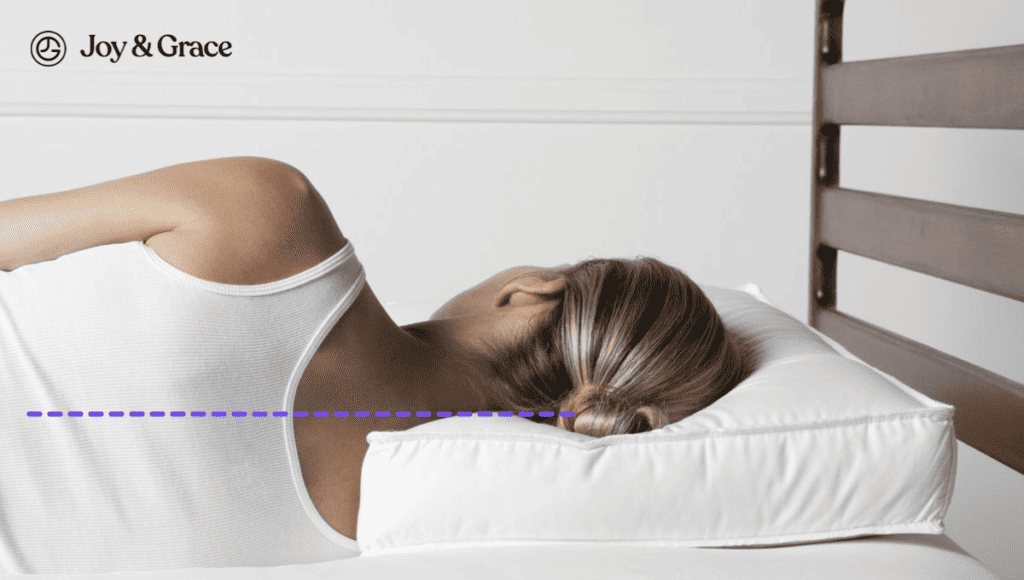Waking up to an aching and stiff neck is not quite the way you want to start your day. In fact, it can feel like a sleep-depriving, around-the-clock pain that really is the ‘pain in your neck.’
For those who lay awake at night, wrestling with the correct sleep position, the right pillow, or the number of pillows needed to deal with neck pain, we see you, and we are here to help.
Can Pillows Affect Neck Pain?
Surprisingly, pillows can play a significant role in neck pain, and it all comes down to the alignment of your spine. When your shoulders and spine are not properly aligned, it can lead to neck pain.
Research shows that using pillows that don’t adequately support your neck and shoulders during sleep can cause neck pain.
When you use a supportive pillow, you reduce the pressure and even the load on the disks between the bones of your neck.
Aside from spinal alignment (affecting the bones), unsuitable pillows can also agitate the muscles of your neck, causing cramps and soreness.
And it doesn’t stop there.
The pain can lead to sleep disruption, which can make the pain even worse. According to some studies, poor sleep quality can even reduce the likelihood that your neck pain will get better. This can lead to a vicious cycle of persistent pain and poor sleep.
But what happens if you have the right pillows? Well, according to a study, the use of proper pillows can help alleviate neck pain and stiffness, headaches, and shoulder pain.
With all that said, you might be curious whether sleeping without pillows is a better option for your neck. Let's delve deeper into this question.
Is It Better To Sleep With A Pillow If I Have Neck Pain?

The critical factor isn't whether you should use a pillow but rather how high your pillow should be. Keep in mind that your neck normally has a slight inward curve. This is the C-shaped curve at the back of your neck when you view it from the side. This curve helps maintain balance and supports the weight of your head.
A study aimed to understand how different pillow heights affect the alignment of the neck and upper back in healthy adults. They tested three pillow heights:
- 0 cm (flat or no pillows)
- 10 cm
- 20 cm
They found that the height of the pillow influenced the natural curves of your spine, with the optimal pillow height being 10 cm. However, the researchers state that this number is solely based on spinal alignment. You should also consider your comfort and satisfaction.
To elaborate further: The general goal when choosing a pillow is to find one that keeps your neck in a neutral position, aligned with the rest of the spine. If your pillow is too high, it can make your neck bend forward unnaturally. On the other hand, if the pillow is too low, such as when lying with no pillows, it can cause your neck to stretch backward in an uncomfortable way.
Pillow height can also affect the activity of your neck muscles. Researchers found that using a neck support pillow can relax your neck muscles. Meanwhile, sleeping without a pillow can make your neck muscles work harder to maintain a stable position.
Another study showed that a pillow height of 10 cm resulted in the least muscle activity in the neck and upper back. Too low (5 cm) or too high (14 cm) pillows increased muscle activity.
In conclusion, the key isn't whether to use a pillow but finding the right height. Research suggests a pillow height of 10 cm is optimal for spine alignment and maintaining a neutral neck. But your comfort matters, too. So, choose a height that balances comfort and proper alignment for a good night's sleep.
Which Pillow Is Best For Neck Pain?

As mentioned, choosing the right pillow can make a huge difference in your sleep quality and pain levels.
A review looked into different pillow parameters and their effects on sleep quality, spinal alignment, and waking symptoms. The parameters were:
- Material
- Height
- Shape
- Thermal properties (cooling or heating)
They found that using a latex pillow with a specific shape (contoured), a height between 7 and 11 cm, and a cooling surface can help improve sleep quality and align the spine. It can also reduce sleep-related pain levels.
According to the review, the pillow should have higher sides and a lower, flattened center. This allows the pillow to accommodate both side and back sleepers.
Another review found that rubber and spring pillows were also effective in reducing neck pain.
You might also consider trying a water pillow. It sounds weird, but according to a study, water pillows provided better sleep satisfaction and pain relief compared to “roll” and “standard” pillows.
Finally, memory foam pillows can also be a good option for some people.
That said, the review suggesting latex pillows reported that:
- Pillow shape and height had a greater effect on spinal alignment than pillow material.
In summary, while exploring options, aim to find a pillow that suits your personal comfort and aligns with the scientifically recommended guidelines for material, height, and shape.
Can I Use A Neck Pillow For Neck Pain?

Yes, using a neck pillow may be beneficial if you’re suffering from acute (recent, short-term) neck pain. For chronic pain, however, according to a 2009 review, there is insufficient evidence to support the use of cervical pillows for reducing pain.
Neck or cervical pillows are essentially contoured pillows that support the natural alignment of your neck. As mentioned above, the contour or shape of the pillow should depend on your sleeping position.
This makes sense, as we probably don’t maintain a single sleeping position the whole night. In fact, healthy adults can change sleeping positions 12 to 20 times per night.
People with neck symptoms are reported to change their sleeping positions more often, spend more time in uncomfortable positions, and stay still in these positions for longer periods compared to healthy individuals.
Who knew pillow talk could be so complicated? Well, to make things more complicated, the firmness or softness of your pillow can also play a role in neck pain.
Should I Sleep On A Hard Or Soft Pillow If I Have Neck Pain?
As we’ve been repeating, pillow height is what really matters for your comfort and quality of sleep.
However, we don’t really take that into consideration when we go pillow shopping. Most of us often pick pillows based on how comfy they feel immediately, but this might not be the best approach. Soft pillows might feel nice at first, but your idea of comfort can change over time.
Interestingly, a firm pillow, which might not seem very cozy initially, can actually be helpful. It keeps your cervical spine stable while you sleep.
So, even if it feels a bit hard at first, a firmer pillow can be better for your neck and back in the long run.
Can A Too Soft Pillow Cause Neck Pain?
It’s possible for a too-soft pillow to cause neck pain. While it might feel comfortable initially, a pillow that's too soft will eventually stop providing adequate support for your neck and head. Over time, a too-soft pillow could cause your head to sink, straining your neck and shoulder muscles and leading to discomfort.
What Is The Best Way To Sleep With Neck Pain?
The answer isn't the same for everyone. It's about finding what helps keep your neck in that “neutral” position best for you. That said, we only really have two options. First off, forget about sleeping on your stomach—that's a no-go. Instead, let's focus on these two contenders:
- Sleeping on your back
- Sleeping on your side
How Do I Sleep On My Side With Neck Pain?
When you sleep on your side, make sure you keep your body aligned. This means keeping your chin and head aligned with the center of your shoulders.
An excellent way to check is to see if your ears are aligned with your shoulder tips. Avoid tilting your head down or twisting your head to the side.
Then, make sure to keep your shoulders aligned with your hips. You can have your legs in two ways: straight and on top of each other or bent in a fetal position.
If you prefer being in the fetal position, make sure not to curl your body too much, and don’t curl your neck.
How Do I Sleep On My Back With Neck Pain?

If you sleep on your back, keep your shoulders flat on the mattress and avoid using pillows that lift your head too high. Try to keep your entire body straight. Also, consider placing a pillow under your knees to support the natural curve of your lower back. This position helps align your spine and reduces strain on your neck.
How Many Pillows Should I Sleep With Neck Pain?
So, how many pillows should you sleep with if you have neck pain? Well, the answer is not one-size-fits-all, unfortunately. Determining the correct number of pillows depends on your preferred sleeping position. Again, as a general rule of thumb, the aim is to maintain your neck's natural curve and alignment.
The pillows' height, shape, and firmness also come into play. For example, if you find one firm pillow uncomfortable, you can try stacking some softer and thinner pillows to see if it works for you. Just make sure not to stack them too high.
How Many Pillows Should I Use If I Sleep On My Back?
When sleeping on your back, you can use one pillow to support your neck’s natural curve—no more, no less! A common mistake is using too many pillows, which can raise the neck too much, resulting in pain and discomfort. Opt for a pillow that's firm enough to keep your head from sinking in during the night but soft enough to cradle your head comfortably.
However, as we mentioned above, your comfort should also be a priority. Experimenting with a combination of thinner and softer pillows might be worth a try to find what suits you best.
How Many Pillows Should I Use If I Sleep On My Side?
For side sleepers, one pillow is also enough. However, as mentioned earlier, side sleepers might need higher pillows to help fill the space between the neck and head.
If you sleep on your side, you can also try adding another pillow between your knees. This can help keep your hips and spine aligned.
How Many Pillows Should I Use If I Sleep On My Stomach?
Finding the perfect pillow configuration for stomach sleepers with neck pain can be quite tricky. The general consensus is that stomach sleepers should use very thin or no pillows to avoid further straining the neck.
Again, sleeping on your stomach is tough on your neck and is recommended to be avoided.
How Do I Use A Pillow For Neck Pain?
Pillow positioning and arrangement matter just as much as pillow count. Your pillow should fill the gap between your neck and the mattress.
- For back sleepers, select a pillow that comfortably fills the space beneath your neck. Ensure it supports your neck and head without tilting your head upward.
- Side sleepers should opt for a thicker pillow that aligns your head with your spine. Make sure your neck is supported and the spine remains straight.
In both cases, the goal is to maintain a natural, neutral alignment of the spine, avoiding any strain or discomfort.
How Do I Know If My Pillow Is Causing Neck Pain?
Pay attention to how you feel when you wake up in the morning to determine if your pillow might be contributing to your neck pain.
Continuous morning neck pain can mean that your pillow might not be providing enough support. If the pain subsides after some stretches and daytime activities, this could be a sign your pillow or sleeping position is to blame.
Another thing is to try to recall how long you’ve had your pillows. It might have lost its support if it's more than 1-2 years old. We know some pillows hold some sentimental value, but it may be time to let them go if they’re causing you pain.
However, if the pain persists or worsens despite making some adjustments, it might be time to visit your healthcare provider. Numerous conditions can cause neck pain, which can worsen if you use the wrong pillow or sleep in uncomfortable positions.
Takeaway
An unsupportive pillow can result in an unnatural bending of the neck. When coupled with poor sleeping posture, a pillow can bring nightmares instead of sweet dreams.
When setting up your bed for a good night's sleep, keep these pillow pointers in mind. First, one pillow may be enough. Aim for an ideal height ranging from 7 to 11 cm, but remember, it's not a strict rule. Position your pillow under your neck and head for optimal support. Lastly, make adjustments to fill the gap between your neck and the mattress, ensuring a comfortable and aligned sleeping posture.
These small changes could make quite a difference and help you have a peaceful night's sleep despite neck pain. Don't just sleep it off; sleep it off right.
Remember, these are only guidelines. Finding the right sleeping position and pillow combination is a matter of personal comfort and trial and error.















